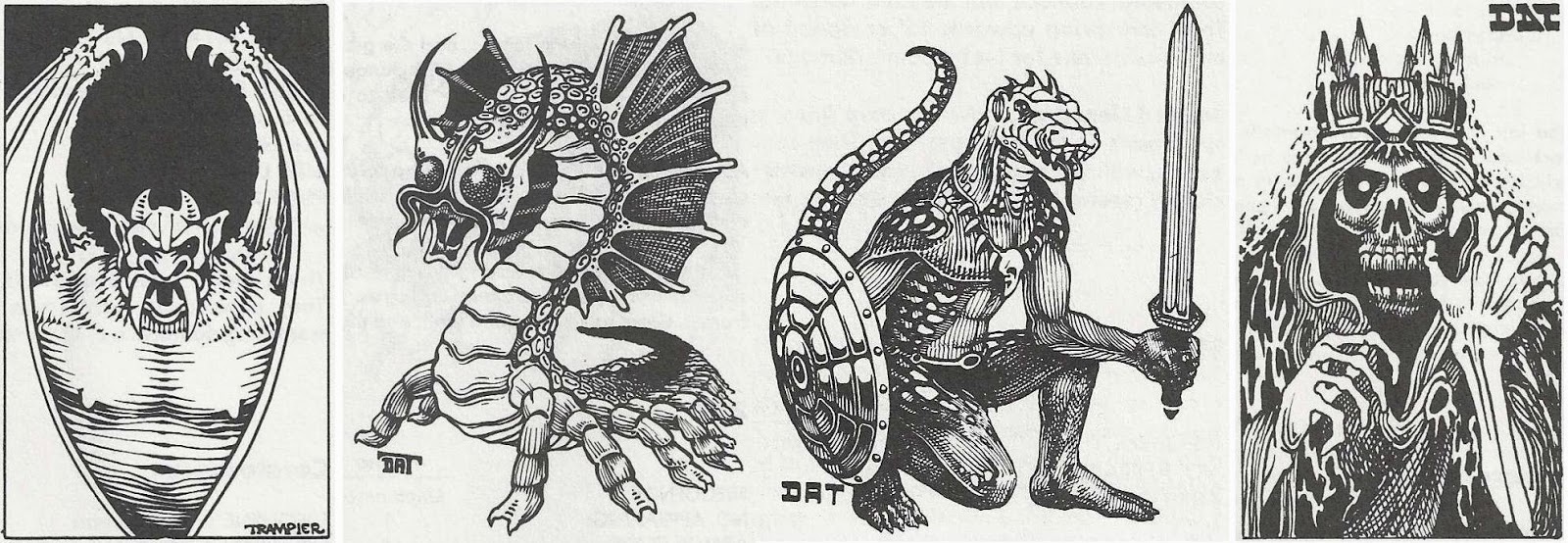 |
| Art by Liz Danforth |
The Dungeon Masters Guide devoted seven paragraphs to the idea of “The Monster as a Player Character.” Basically, Gygax advised that players should not be allowed to play monster characters. At one point, he relented enough to state, “The truly experimental-type player might be allowed to play...a monster character for a time so as to satisfy curiosity.” At the end of an essay of discouragement, Gygax finally said Dungeon Masters can do what they want with their own worlds but still admonished, “you are virtually on your own with regard to monsters as player characters.” This dissuasive attitude was something of a departure from Holmes' remarks two years earlier: “At the Dungeon Master's discretion a character can be anything his or her player wants him to be. Characters must always start out inexperienced and relatively weak...” While permissive, Holmes supplied no other guidance.
Not only did Tunnels & Trolls allow player characters to be monsters, but Ken St. Andre designed a T&T compatible game where player characters could only be monsters. This game – Monsters! Monsters! – was published three years before Gygax advised against the concept and one year before Holmes' minimal concession.
The original Tunnels & Trolls did not have descriptions for monsters. Dungeon Masters – yes, the original rules referred to Dungeon Masters – were expected to design their own. However, monsters in T&T were defined by a number called 'monster rating'. “Very puny monsters...have ratings below 30,” St. Andre wrote, “Very powerful monsters might have individual ratings up in the hundreds.” The number of dice rolled for a monster in combat was based on its rating (eventually simplified to monster rating divided by ten). On the first 'conflict turn', half of the monster rating was added to the dice total. On subsequent conflict turns, only one-quarter was added. Damage was subtracted from monster rating; as monsters suffered damage, the damage they were able to inflict was reduced.
Monsters! Monsters! was “produced and edited” by Steve Jackson and was published by Metagaming. Monster ratings weren't a part of M!M! ; each monster was a character and was defined by attributes just like “normal” player characters. A player could choose a type of monster to play or draw a random playing card; each of the 52 monsters on the monster table was associated with a specific card. A character might be a balrog (king of diamonds) or a slime-mutant (two of hearts) or even human scum (two of clubs). As the mention of 'balrog' suggests, various literary monsters were provided: From Tolkien, along with balrogs, there were hobbits (technically 'black hobbits' due to their categorization as monsters) as well as orcs (and half-orcs); Tsathoguas from C. A. Smith; shoggoths and night-gaunts from Lovecraft; Snarks (misspelled 'Shark' in the Monster Glossary) from Lewis Carroll; shadowjacks from Zelazny; and M!M! demons were inspired by L. Sprague de Camp's works. The table provides attribute multipliers for the various monsters. (For instance, a yeti multiplies its strength by four while a gremlin multiplies its constitution by one-half.) These attribute multipliers allowed detailed monster creation in T&T and also provided means to create non-human (but non-monstrous) player characters types like elves and dwarves.
Experience points were awarded in M!M! for expected behavior like acquiring treasure and killing or conquering enemies, but also for obtaining attractive captives of the opposite sex (“No points for ugly people”), destructiveness (including “wanton cruelty” and “general rottenness”), and sating one's appetite.
Just as 'normal' characters went dungeon delving in T&T, characters in M!M! were expected to raid settlements. To this end, a sample farming village was mapped and described, the inn of the village was mapped and described in greater detail. Attributes were supplied for various residents (with names like Desmond Mudminder, Bolinger Zangala, and Gort Glibtongue). While these residents are targets in M!M!, they could easily serve as typical non-player characters in a traditional game. St. Andre encouraged Game Masters (thus called in Monsters! Monsters! ) to create their own settings for monsters to invade. St. Andre mentioned he designed Khosht, a city with a population of 20,000, for use in his games.
From St. Andre's Monsters! Monsters! Introduction:
So it was only natural that the monsters should come out of their tunnels and dungeons to strike back at the smug world of Men, Elves, Dwarves, Hobbits, etc., who had been so greedily despoiling their homes and treasures...A monster lives by a completely different code of ethics, affording a splendid opportunity to get rid of the impure and perverted impulses which affect most of us – impulses it's hard to express while playing a hero.









